Dual significance of Sambuddhatva Jayanthi
By Kalakeerthi EDVIN ARIYADASA
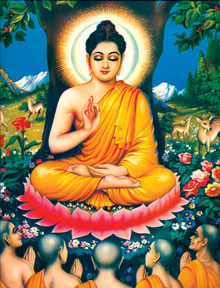 |
|
The Buddha's First Discourse to the
five ascetics at Isipathana Migadaya |
 "Oh
Supreme! Let thy great law be uttered!" "Oh
Supreme! Let thy great law be uttered!"
Whereupon the Master cast his vision forth on flesh,
Saw who should hear and who must wait to hear,
As the keen sun gliding the lotus lakes
Seeth which buds will open to his beams,
And which are not yet risen from the roots.
Then spake divinely smiling, "Yea, I preach!
Who so listen let him learn the Law!"
-Light of Asia,
Sir Edwin Arnold
This is the sacred moment at which we celebrate the Attainment of
Supreme Enlightenment by Ascetic Siddhartha, 2,600 years ago.
While we are totally focused on the 2,600th anniversary of the
Attainment of Enlightenment, we are quite likely to overlook that 2011
marks the 2,600th anniversary of the birth of Buddhism as well.
When Ascetic Siddhartha achieved Supreme Enlightenment, it was, in
the first instance, a personal transcendental triumph. The birth of
Buddhism had to await some more time.
Inner joy
Experiencing the inner joy of Enlightenment, the Buddha was hesitant
about declaring to the world his profound spiritual discovery. It was at
this stage that Maha Brahma entreated the Buddha to enlighten the world
about the Great Law He has realised.
The Supremely Enlightened Buddha decided that the first beneficiaries
of the Law He realised should be His co-seekers, the five ascetics -
Kondanna, Bhaddiya, Vappa, Mahanama and Assaji.
The Buddha travelled about 200 miles to meet the five. They were
pursuing their religious practices at Isipathana Migadaya, in the
vicinity of the city of Benares.
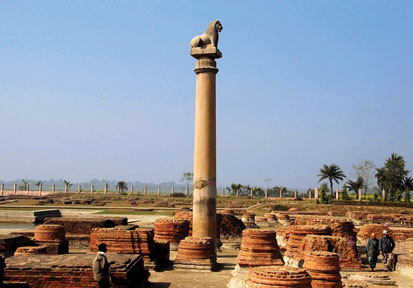 |
|
The pillar of Asoka |
This sacred venue, currently known as Saranath, had been a haven for
men of religion, even before the Buddha's day. 'Isipathana' implies 'the
assembly place of seers and sages'.
'Migadaya' is the term given to an animal sanctuary. But, in recent
times there has been an interesting development relating to the name
'Migadaya'. Today the place is known by the expression 'Deer Park'. This
is clearly and starkly a misnomer.
The word 'Miga' in the original name does not refer only to the deer.
In Pali, 'Miga' is applicable to all beasts and animals. In Sanskrit the
word is 'Mrga'. It is interesting to note in this context that a monkey
is described in Sanskrit as 'Shaka Mrga' (the animal of the
tree-branch).
Animal sanctuary
In the early days this was an animal sanctuary - a place set aside
for the animals to live and roam about freely. It stands to reason to
assume that no ruler would have a sanctuary only for the deer. No hunter
would seek out other animals, avoiding the hunting of the deer. Someone
would have translated the word Miga into English as 'deer' and the place
was promptly named 'Deer Park'.
To mark the 2,600th anniversary of the Buddha's Attainment of
Enlightenment, we could request the authorities to take steps to change
the name to read as 'Animal Sanctuary,' setting aside the current
misnomer 'Deer Park'.
The specific location had been referred to as the 'Kalandaka Nivape'
- the place where the squirrels were fed.
All these cumulatively established, beyond a shadow of a doubt, that
the significance of the original term 'Miga Daya', was 'Animal
Sanctuary'.
When the Buddha was seen approaching, the five ascetics felt
convinced that he was coming back to them as his quest has failed. They
decided that they will not accord to him the customary honours endowed
upon a visiting monk. But, as the Buddha approached closer, the resolve
of the five ascetics flagged. The five fellow-seekers could not help but
note that an extraordinary appeal had enriched the Buddha's total
personality. The Buddha's mien gleamed with an ethereal glow. The five
ascetics realised that a vast spiritual transformation had occurred
within their revered guest.
Monument
This initial meeting between the Buddha and the five ascetics took
place at Chankandi, where a monument had been constructed in quite an
early era. Today segments of the original building can be seen at this
site.
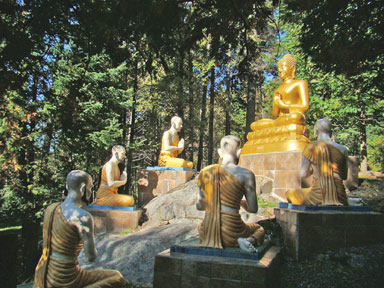 |
|
A monument in Vietnam
depicting the Buddha’s First Discourse |
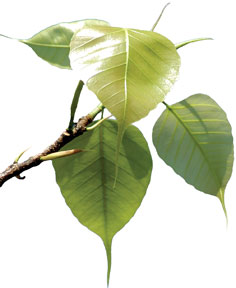 Although
the five ascetics accorded Him a deference, they continued to assume
that the Buddha's spiritual attainment may not be as lofty as theirs.
They insisted on addressing Him as 'avuso' (Friend) an expression fit
for a junior or an equal. Although
the five ascetics accorded Him a deference, they continued to assume
that the Buddha's spiritual attainment may not be as lofty as theirs.
They insisted on addressing Him as 'avuso' (Friend) an expression fit
for a junior or an equal.
The Buddha put matters right by mildly reminding them that they
should now address Him as Samma Sambuddha, The Supremely Enlightened
Being - indicating that He has fully completed His spiritual effort and
that His quest for truth has now been successfully culminated.
All the qualms and doubts that troubled the five ascetics were now
totally swept away. They were fully prepared to listen to the Supremely
Enlightened Buddha.
To these eager spiritual truth-seekers, the Buddha expounded the
profound Law He had so strenuously realised.
In other words, the Buddha presented to the five ascetics the
immortal report of His spiritual odyssey.
The first sermon of the Buddha, setting down the essence of His
spiritual realisation, is well-known as the Dhammacakka Pavattana Sutta
- The Discourse on the Turning of the Wheel.
With this Supreme Manifesto, Buddhism was born 2,600 years ago.
It is only with this declaration in the Discourse on the Turning of
the Wheel that the spiritual system known as Buddhism appeared before
mankind, to lead men and women to liberation (Moksha) from the cycle of
recurrent births.
Birth of Buddhism
The salutary outcome of all this is that in 2011 we celebrate not
only the Attainment of Supreme Enlightenment, but also the historical
Birth of Buddhism.
Before we take a look at this First Discourse, we must focus on the
eternally hallowed spot where this sermon was first proclaimed.
Dhammasoka, the Emperor of Righteousness, visited Isipathana as an
ardent pilgrim. The imperial pilgrim had several edifices set up at this
spot.
A prominent structure the Emperor built at this spot is a solid block
known as "Damek". It is quite clear that this is not a conventional
stupa. We have to surmise that this intriguing architectural enigma is
nothing but a monument.
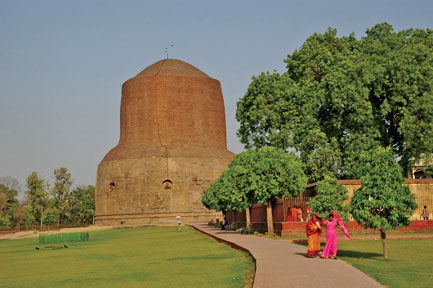 |
|
Saranath, the venue of
the Buddha's First Discourse |
It stands to reason to conclude that the only event that deserves a
monument at this location is the exact spot where the Buddha proclaimed
His Dhammacakka Pavattana Sutta.
The monument is described as "Damek", an expression for Dhammacakka.
It is quite surprising to note that Damek has a very close affinity to
the Sinhala word Damsak, which means Dhammacakka.
Asoka pillar
Emperor Asoka set up a pillar at this site. This was originally 50
feet high. At present it has about seven or eight feet left in the
ground. The pillar was surmounted by a capital, with four lions standing
back to back.
These lion figures are preserved at the Saranath Museum. It is indeed
remarkable that they still retain their original polish, lustre and
expression.
Originally, the four lions held a 32-spoked Dhammacakka (Wheel of
Dhamma). A fragment of this wheel is now at the Saranath Museum.
The Asokan Lion is the National Emblem of India and the Dhammacakka
adorns the Indian National Flag as its central motif. The original
Dhammarajika Vihara was also built at this site by Emperor Asoka.
Since that day the site has weathered many vicissitudes. But this
sacred venue still continues to engender a deeply transforming sense of
tranquillity. When devoted pilgrims intone Dhammacakka Pavattana Sutta
in sonorous rhythms, one cannot help but feel that the environment
itself is listening in hushed silence.
In the calm and serene atmosphere of Isipathana - The Haven of Sages,
one tends to assume that in the forests surrounding this holy site,
there could very well be birds and animals descending from those who had
the good fortune to listen to the Supremely Enlightened Buddha's
cadenced voice delivering the Dhammacakka Pavattana Sutta, about 40
generations ago (2,600 years ago to be precise).
The Buddha's Dhammacakka Pavattana Sutta brought about the formal
Birth of Buddhism. It is a remarkable spiritual statement in the whole
of human history.
The structure of this discourse possesses some unusual
characteristics. Its introductory phrases are conventional.
Ven. Ananda Maha Thera presents the discourse with the conventional
introduction "Thus have I heard," (Evam me sutam). And, as usual Ven.
Ananda Maha Thera gives a brief background about the venue, and the
circumstances of the presentation of the discourse.
"On one occasion, the Blessed One was living in Migadaya at
Isipathana. Then He addressed the group of five bhikkhus".
As quoted by Ven. Ananda Maha Thera, the Buddha expounds His
realisation to the group of five bhikkhus and concludes His discourse
with these words: "And, a vision of insight arose in me thus: Unshakable
is the deliverance of my heart. This is the last birth. Now, there is no
more re-becoming (rebirth)."
After this concluding statement of the Buddha, the structure of this
discourse takes on a new aspect.
The discourse goes on to record what happened after the Buddha
concluded His statement.
Who provides this report? Is it Ven. Ananda Maha Thera or is it a
later commentator?
In the concluding section of this discourse, there is a highly
impressive report of the manner in which the word of the Buddha spread,
from stage to stage, until it reached the Akanittha abode of the
Brahmas.
The process through which the Buddha's timeless word travelled to
infinity is a miraculous communications phenomenon.
This is how the process is recorded in the Dhammacakka Pavattana
Sutta.
The Buddha's words were heard by terrestrial deities. They echoed the
Buddha's words, so that deities in the closest heavenly abode could hear
them.
Those in the closest heavenly abode echoed the Buddha's word for the
gods in higher realms. This way, the Buddha's word travelled in a long
series of relays from earth to the highest heavens.
This is an advanced system of communication.
This system is described in the latter section of this discourse, in
an interesting phrase - Saddam anussa vesum (The sound was re-echoed).
In the formal chanting, this discourse, when the phrase Saddam anussa
vesum occurs, a loud drum is sounded.
This sublime process of communication through a whole series of
sound-relays should be studied in-depth. This communication process can
be even diagrammatically portrayed.
For us, what is of high significance is the fact, that the person or
persons who added this note to this discourse would have been aware that
the news of the Birth of Buddhism reached far worlds.
Ascetic Siddhartha attained Supreme Enlightenment 2,600 years
ago.And, with the presentation of the Discourse of the Turning of the
Wheel, Buddhism was born.
That too, 2,600 years ago.
|

